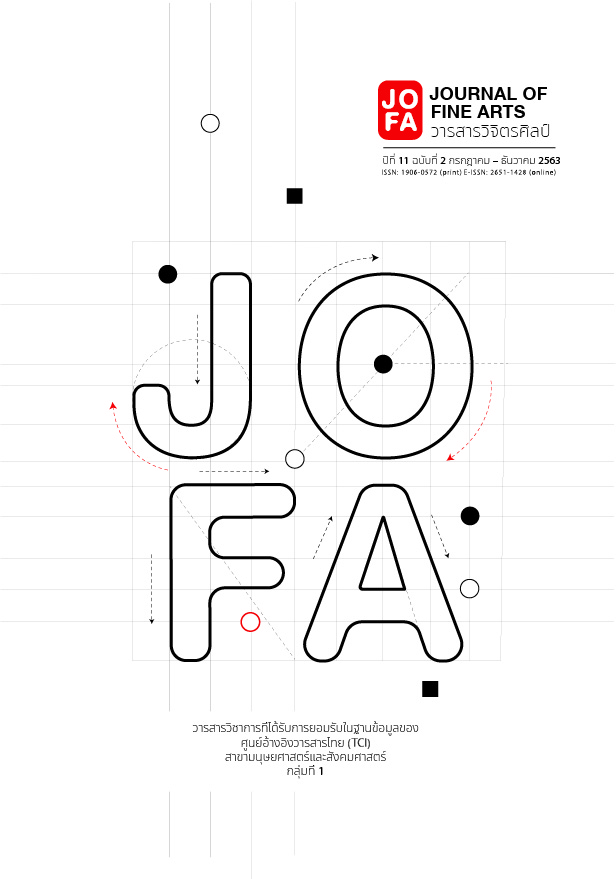The study of stucco patterns at Wat Uposatharam, Uthai Thani province for the development of leather product designs
Main Article Content
Abstract
The objectives of this study were to 1). Study and collect the stucco patterns at Wat Uposatharam, Uthai Thani province; 2) analyze the stucco patterns at Uposatharam, Uthai Thani province and 3) design the leather product using the identity of stucco patterns at Wat Uposatharam, Uthai Thani province.
The results showed that most stucco sculptures at Wat Uposatharam, Uthai Thaini were created for decorating the gables, roof wings, porches, window façades, arches, bases of Sema and pillars of the main hall, ordination hall, octagonal mondop and the 3-era pagoda. These sculptures had the characteristics of the early Rattanakosin art with the combination of Thai, Chinese and European arts. The stucco patterns could be divided into four types: 1) Patterns related to religious beliefs and images which could be found on the gables, roof wings of the ordination hall, main hall and the octagonal mondop. These patterns reflected beliefs and Buddhist influences and served as the remarkable centers. These patterns were such as the statue of Indra ridding Erawan elephant at the gable of the ordination hall, the Buddha statue in the attitude of looking holding an almsbowl and standing in the curved frame of the octagonal mandop.
2) Patterns related to literatures and Himmapan creatures demonstrating the value of Thai art created language that had been prosperous since ancient times. These patterns were such as painted stucco of Hanuman and Angada tricking and stealing Ravana’s heart from Kobutra the hermit situated at the gable behind the ordination hall, the statue of Kodchasri and the Lion at the roof wings behind the ordination hall and 3) Flora and vegetative patterns, the decorative patterns at the gable, roof wings, window façades, arches consisting of cotton rose, leaves and climbing ivy; 4) Thai design patterns consist of inverted lotus, lotus, flower (Pra Jam Yam) and continuous pattern (Na Kra Dan) for decorating the 3-era pagoda and bases of Sema including face pattern (Na Khob) appeared on Northern window façades of
the ordination hall.
The industrial embroidery machine was used to create patterns on the leather bag prototypes including
1) octagonal handbag, 2) cylinder bag, 3) long wallet, 4) wallet and 5) coin and card wallet. The evaluation showed that the overall preference of consumers toward the product prototypes were in range of high to highest level.
Article Details
References
“Khana Kammakān Fāi Pramūan ʻĒkkasān Læ Čhotmāihēt Nai Khana Kammakān ʻAmnūai Kān Čhat Ngān Chalœ̄m Phrakīat Phrabātsomdetphračhaoyūhūa. Watthanatham Phatthanākān Thāng Prawattisāt ʻĒkkalak Læ Phūmpanyā Čhangwat ʻUthai Thānī”. [Culture History Development Identity and Wisdom of Uthai Thani]. Bangkok: Kurusapa Printing Ladphrao, 1999.
Pinsuwanbutr, J. “Kānsưksā Phāp Čhittrakam Fā Phanang Wihān Wat ʻu Pōt Thā Rām Khwāmsamphan Kap Chāo Lāo Nai Thō̜ngthin Čhangwat ʻUthai Thānī”. [A study of temple murals at Wat Uposatharam of relationships with local Laos people in Uthai Thani Province]. Department of Anthropology, Faculty of Archaeology, Silpakorn University, 2003.
Thai Heritage Treasury. “Mō̜radok Thāng Phra Phut Sātsanā”. [Buddhist heritage]. Accessed January 30, 2018. http://www.thaiheritage.net/nation/oldcity/uthaithani7.htm.
The office of industrial economics. ʻĒkkasān Phœ̄iphrǣ ʻUtsāhakam Nā Rū Khwām Rū Bư̄angton Kīeokap ʻUtsāhakam Rō̜ngthao Læ Khrư̄ang Nang. [Published documents on Introduction to the footwear and leather industry]. Bangkok: Wongsawang, 2011.
Wichensri, N. “Klum Khrư̄ang Nang Rēng Kǣ Panhā Khačhat ʻUppasak Samkhan Wang Raksā Tamnǣng Sūnklāng Fǣchan Nai ʻĒchīa”. [ Leather based industry club. The Federation of Thai Industries accelerate problem-solving and eliminate important obstacles and hoping to maintain the position of fashion center in Asia]. Accessed July 29, 2019. https://www.ryt9.com/s/iq03/2996406.
Wirunphat, C. “Phāp Pūnpan Bon Fā Phanang Nai Wihān Wat Bāng Kaphō̜ʻŌ̜mō̜ ʻAmphawā Čhangwat Samutsongkhrām”. [Stucco decorated internal wall of vihara of Wat Bangkapom at Amphawa district in Samut Songkhram province]. Veridian E-Journal Slipakorn University 4 (2): 44 - 62.


